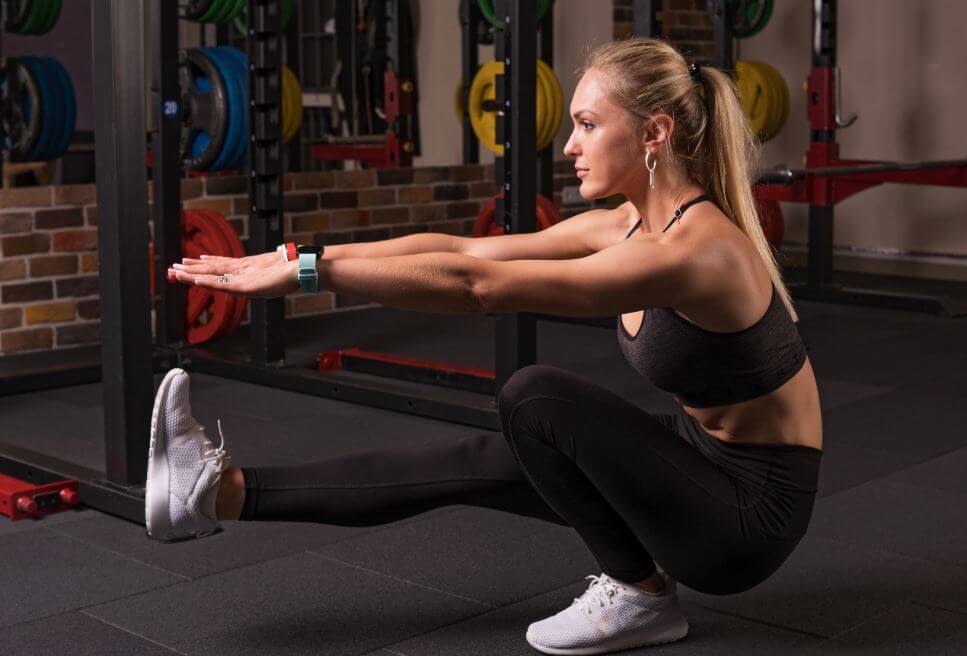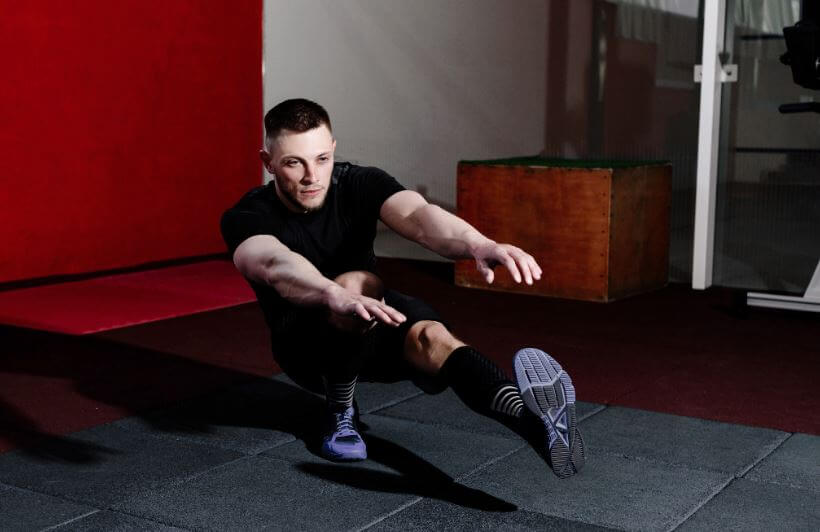Tips for Mastering Pistol Squats

Anyone who says squats are easy hasn’t tried doing pistol squats yet! Pistol squats are one of the hardest exercises ever! But they’re more than effective so we recommend adding them to your routine. We’ll share some tips on how to master them in our post today.
Try pistol squats
Pistol squats are an intense exercise. They don’t just work out your glutes but also require balance and coordination.
So how do you do a pistol squat? Start by standing with your legs together. Next, extend your right leg out in front of you (shifting your bodyweight onto your left knee). Now, bend your left knee as you use your hands to maintain your balance and always keep your back straight.
Your right leg should always be extended and off the floor. When you’re standing, keep your leg diagonal to the floor and as you lower your body, it should become parallel to the floor. Keep your balance by moving your arms in front of you as you lower yourself down. Then, move them back to your sides when you return into the starting position.
Pistol squats might look easy in a demonstration… but we challenge you to do them without losing your balance!

Tips on mastering this exercise
First and foremost, you have to practice, practice and practice. But you can also check out these techniques and keys to make sure you nail them and get the most out of the workout:
1. Start gradually
Stability and balance are skills that you build over time. With that in mind, we suggest using a little help when you’re first starting out. For example, resistance cords can be a huge help. You’ll have to move your arms but they’ll keep you more stable.
Some people try supporting themselves on gym machines and others, a partner or their personal trainer. Little by little, you’ll need less help to keep your balance.
2. Try pistol squats: exercise your ankles
These squats demand a strong lower body. Your ankles will have to support almost your entire bodyweight. If they’re not strong enough, you’ll more than likely topple over or be unable to complete the exercise.
Strengthen your ankles by adding this exercise to your workout routine: stand in front of a wall on tip-toe with your feet together. Hold the position for a few seconds and lower yourself back down without letting your heels touch the floor.
Once you find yourself breezing through the exercise, increase the difficulty: do the same movements on a step and make sure that your heels are never touching the floor.
3. Maximize mobility
The dynamism that the exercise requires can be one of the biggest hurdles in squat pistols. But how do you work on that? Try sessions that work out the mobility of your ankles and knees. By working on the movement, you’ll also reduce your risk of suffering an injury, such as a sprain.
Exercise sessions can be as simple as sitting with your back straight and moving your ankles in a clockwise and counter-clockwise motion for a minute. We also recommend trying to do exercises with ankle-weights.

4. Strengthen your legs
Lastly, you need to have legs of steel for perfect execution. There are all kinds of exercises, with or without machines, that can help you make it happen.
If your legs are strong enough, you can tackle any exercise. Here’s an idea: try doing normal squats but add a barbell with a disk on each end. Increase the weight every two or three weeks.
Pistol squats are just too good to pass up: balance, strength, coordination, flexibility and a behind that’ll make all your gym buddies jealous. Give them a try, taking small steps until you can do 10 reps on each side.
The best part about these squats is that you can always make them more challenging by adding ankle weights, dumbbells or back-weights. Add them to your goals and power through your workout sessions as best you can.
Anyone who says squats are easy hasn’t tried doing pistol squats yet! Pistol squats are one of the hardest exercises ever! But they’re more than effective so we recommend adding them to your routine. We’ll share some tips on how to master them in our post today.
Try pistol squats
Pistol squats are an intense exercise. They don’t just work out your glutes but also require balance and coordination.
So how do you do a pistol squat? Start by standing with your legs together. Next, extend your right leg out in front of you (shifting your bodyweight onto your left knee). Now, bend your left knee as you use your hands to maintain your balance and always keep your back straight.
Your right leg should always be extended and off the floor. When you’re standing, keep your leg diagonal to the floor and as you lower your body, it should become parallel to the floor. Keep your balance by moving your arms in front of you as you lower yourself down. Then, move them back to your sides when you return into the starting position.
Pistol squats might look easy in a demonstration… but we challenge you to do them without losing your balance!

Tips on mastering this exercise
First and foremost, you have to practice, practice and practice. But you can also check out these techniques and keys to make sure you nail them and get the most out of the workout:
1. Start gradually
Stability and balance are skills that you build over time. With that in mind, we suggest using a little help when you’re first starting out. For example, resistance cords can be a huge help. You’ll have to move your arms but they’ll keep you more stable.
Some people try supporting themselves on gym machines and others, a partner or their personal trainer. Little by little, you’ll need less help to keep your balance.
2. Try pistol squats: exercise your ankles
These squats demand a strong lower body. Your ankles will have to support almost your entire bodyweight. If they’re not strong enough, you’ll more than likely topple over or be unable to complete the exercise.
Strengthen your ankles by adding this exercise to your workout routine: stand in front of a wall on tip-toe with your feet together. Hold the position for a few seconds and lower yourself back down without letting your heels touch the floor.
Once you find yourself breezing through the exercise, increase the difficulty: do the same movements on a step and make sure that your heels are never touching the floor.
3. Maximize mobility
The dynamism that the exercise requires can be one of the biggest hurdles in squat pistols. But how do you work on that? Try sessions that work out the mobility of your ankles and knees. By working on the movement, you’ll also reduce your risk of suffering an injury, such as a sprain.
Exercise sessions can be as simple as sitting with your back straight and moving your ankles in a clockwise and counter-clockwise motion for a minute. We also recommend trying to do exercises with ankle-weights.

4. Strengthen your legs
Lastly, you need to have legs of steel for perfect execution. There are all kinds of exercises, with or without machines, that can help you make it happen.
If your legs are strong enough, you can tackle any exercise. Here’s an idea: try doing normal squats but add a barbell with a disk on each end. Increase the weight every two or three weeks.
Pistol squats are just too good to pass up: balance, strength, coordination, flexibility and a behind that’ll make all your gym buddies jealous. Give them a try, taking small steps until you can do 10 reps on each side.
The best part about these squats is that you can always make them more challenging by adding ankle weights, dumbbells or back-weights. Add them to your goals and power through your workout sessions as best you can.
All cited sources were thoroughly reviewed by our team to ensure their quality, reliability, currency, and validity. The bibliography of this article was considered reliable and of academic or scientific accuracy.
- Glavina, B., & Pérez, J. (2009). Actividad muscular lumbar durante el ejercicio de sentadillas y su relación con sujetos de diferentes características físicas. Revista Iberoamericana de Fisioterapia y Kinesiologia. https://doi.org/10.1016/j.rifk.2009.10.005
This text is provided for informational purposes only and does not replace consultation with a professional. If in doubt, consult your specialist.








